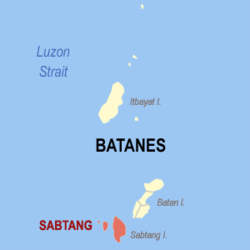Sabtang, Batanes
| Sabtang | ||
|---|---|---|
| Municipality | ||
|
| ||
| ||
 Map of Batanes showing the location of Sabtang | ||
.svg.png) Sabtang Location within the Philippines | ||
| Coordinates: 20°20′N 121°52′E / 20.333°N 121.867°ECoordinates: 20°20′N 121°52′E / 20.333°N 121.867°E | ||
| Country | Philippines | |
| Province | Batanes | |
| District | Lone District | |
| Barangays | 6 | |
| Government[1] | ||
| • Mayor | Maxilindo E. A. Babalo | |
| Area[2] | ||
| • Total | 40.70 km2 (15.71 sq mi) | |
| Population (2010)[3] | ||
| • Total | 1,637 | |
| • Density | 40/km2 (100/sq mi) | |
| Time zone | PST (UTC+8) | |
| ZIP code | 3904 | |
| Dialing code | 78 | |
| Income class | 6th class | |
Sabtang is a sixth class municipality in the province of Batanes, Philippines. According to the 2010 census, it had a population of 1,465 people.[3]
Sabtang is the southernmost island municipality of the Batanes island group which is composed primarily of Sabtang Island, as well as two nearby smaller and uninhabited islands: Ivuhos and Dequey. The municipality is known for its lighthouse and the old stone houses of the Ivatan villages of Chavayan and Savidug. Like Batan Island to the north, Sabtang also has a few Mission-style churches and white sand beaches.
History
The Spanish missionary Fr. Artiquez first visited the Island of Sabtang in 1786 [4] after receiving an affirmative response from the island to learn about the Christian faith. The success of the first visit led to two more evangelical trips resulting in the baptism of 181 children and the study of the catechism among the adult natives. The evangelization of Sabtang was cut short due to he failing health of the Spanish missionaries. For this, the inhabitants of Sabtang remained faithful to old traditions especially in the administration of justice by vendetta and murder.[4]
In 1791, the then most powerful chief in Sabtang named Aman Dangat showed defiance of the government of Governor Joaquin del Castillo by killing the Spanish soldiers who went to Sabtang to procure supplies. Lieutenant Tomas Nuñez led the troops to capture the rebels. Aman Dangat was put to trial and admitted to the crime. He later on asked to be baptized. The inhabitants of Sabtang were then forced to resettle in San Vicente and San Felix in Ivana to be better supervised by the government.[4]
Some forty years after the resettlement, the Sabteños were allowed to visit their native island and gradually these visits allowed them to build homes in their erstwhile land. The government allowed this to happen on the condition that houses should be constructed in lowlands.[4] To sustain the spiritual care for the Sabteños, a new mission was opened in Sabtang in 1845 under the patronage of St. Vincent Ferrer with Fr. Antonio Vicente as its first vicar. Fr. Antonio Vicente is credited to have built the Sabtang Church, together with a convent, a school, and a courthouse.[4]
Barangays
Sabtang is politically subdivided into 6 barangays.[2]
- Chavayan
- Malakdang (Pob.)
- Nakanmuan
- Savidug
- Sinakan (Pob.)
- Sumnanga
Demographics
| Population census of Sabtang | ||
|---|---|---|
| Year | Pop. | ±% p.a. |
| 1990 | 1,737 | — |
| 1995 | 1,434 | −3.53% |
| 2000 | 1,678 | +3.43% |
| 2007 | 1,465 | −1.85% |
| 2010 | 1,637 | +4.12% |
| Source: National Statistics Office[3] | ||
Image gallery
-
A quiet beach in Sabtang Island
References
- ↑ "Official City/Municipal 2013 Election Results". Intramuros, Manila, Philippines: Commission on Elections (COMELEC). 11 September 2013. Retrieved 3 February 2014.
- ↑ 2.0 2.1 "Province: BATANES". PSGC Interactive. Makati City, Philippines: National Statistical Coordination Board. Retrieved 3 February 2014.
- ↑ 3.0 3.1 3.2 "Total Population by Province, City, Municipality and Barangay: as of May 1, 2010". 2010 Census of Population and Housing. National Statistics Office. Retrieved 3 February 2014.
- ↑ 4.0 4.1 4.2 4.3 4.4 González Alonzo, Fr. Julio, O.P. (1966). "The Batanes Islands", in Acta Manilana, Manila: University of Santo Tomas Research Center
External links
 |
Itbayat Luzon Strait |
Ivana |  | |
| South China Sea | |
Philippine Sea | ||
| ||||
| | ||||
| Balintang Channel (Luzon Strait) Calayan, Cagayan |
| ||||||||||||||


